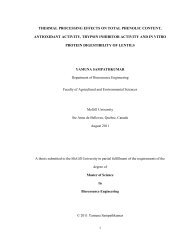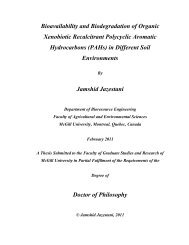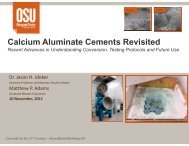Postharvest treatments to reduce chilling injury symptoms in stored ...
Postharvest treatments to reduce chilling injury symptoms in stored ...
Postharvest treatments to reduce chilling injury symptoms in stored ...
Create successful ePaper yourself
Turn your PDF publications into a flip-book with our unique Google optimized e-Paper software.
affected fruit has no external symp<strong>to</strong>ms either at the time of pick<strong>in</strong>g or while ripen<strong>in</strong>g.<br />
The affected portion gets prom<strong>in</strong>ent when the fruit gets cut. The exact cause of spongy<br />
tissues is still unknown. It has been noted that the affected fruit pulp has higher acidity,<br />
low pH, low ß-carotene content, sugar and ascorbic acid. The amylase and <strong>in</strong>vertase<br />
activity is also <strong>reduce</strong>d. In Alphanso mangoes the <strong>in</strong>cidence of spongy tissue may be<br />
<strong>reduce</strong>d if fruits are harvested earlier and ethylene is used for subsequent ripen<strong>in</strong>g (Lad et<br />
al., 1985).<br />
2.4.3 Black-tip<br />
In black-tip disorder, the distal end of the fruit becomes yellow, and mesocarp and<br />
seed are unaffected <strong>in</strong> early stage, while later on the entire tip of the fruit turns brownish<br />
black <strong>in</strong> color (Ram, 1989). The affected portion gets hard and its growth is retarded. The<br />
fruit becomes unattractive and loses its quality. Sprays of sodium carbonate, sodium<br />
hydroxide and borax can prevent the <strong>in</strong>cidence of black tip <strong>in</strong> mango.<br />
2.4.4 Soft-nose<br />
In 1957, Young described soft-nose as breakdown of fruit flesh at the fruit apex.<br />
The mesocarp shows premature soften<strong>in</strong>g at distal end. This disorder may be related <strong>to</strong><br />
calcium deficiency. Cultivars Kent and Ameeri from Canary Island were found more<br />
susceptible <strong>to</strong> this disease (Galan Sauco et al., 1984). The fruit, which has low calcium<br />
content, is the most affected by this disease.<br />
2.4.5 Chill<strong>in</strong>g <strong><strong>in</strong>jury</strong> (CI)<br />
To ma<strong>in</strong>ta<strong>in</strong> the quality of harvested horticultural crops, temperature is one of the<br />
most predom<strong>in</strong>ant fac<strong>to</strong>r. Rate of metabolic processes of the commodity can be <strong>reduce</strong>d<br />
by lower<strong>in</strong>g the temperature. When tropical and subtropical crops are s<strong>to</strong>red at low<br />
temperatures, certa<strong>in</strong> physiological disorder have been observed such as CI. Due <strong>to</strong> this<br />
phenomenon, product s<strong>to</strong>rage life is limited, and leads <strong>to</strong> significant degradation of<br />
quality.<br />
The primary cause of CI is thought <strong>to</strong> be the damage of cell membrane that<br />
<strong>in</strong>itiates a cascade of secondary reaction. CI is a time and temperature problem. Mango<br />
fruits are subjected <strong>to</strong> CI when s<strong>to</strong>red below 10 °C. The symp<strong>to</strong>ms <strong>in</strong>clude grayish scald-<br />
17









